Cuteness delights in hybrids and opposites (old/young, ugly/adorable, masculine/feminine, human/non-human), which means it slips easily into the realms of the uncanny and the grotesque. This ambiguity allows for things that could otherwise be seen as divergent, troubling or malign to exist in a state of acceptance, kindness or even love. In recognising and honouring otherness, cute allows us to be fully ourselves, without judgment or boundaries, and offers a unique space outside of the norm with the potential for reinvention and becoming.
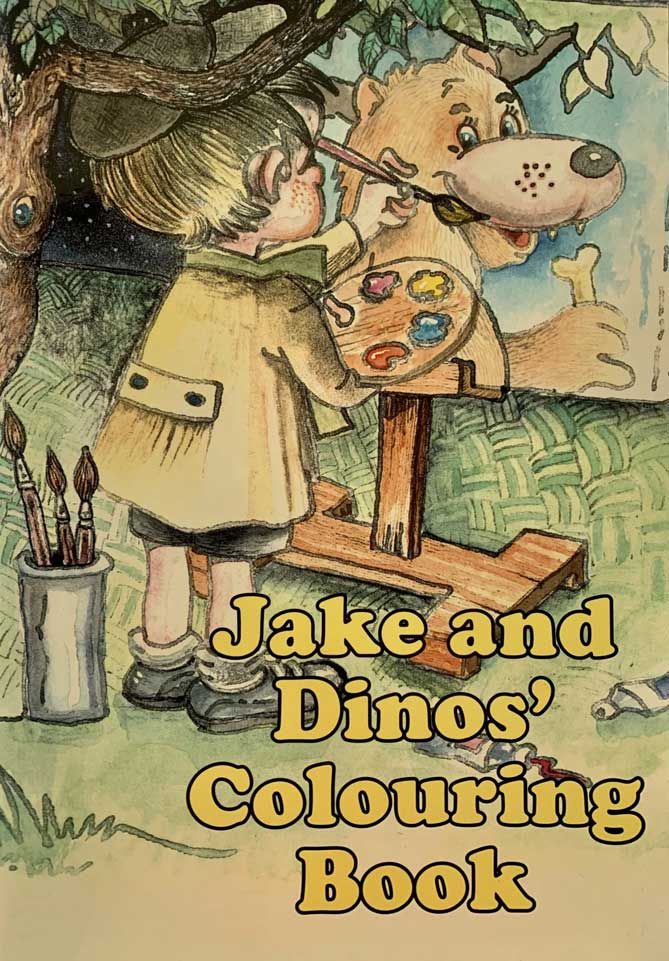
1
Jake and Dinos’ Colouring Book
2010
Jake and Dinos Chapman
Book
This colouring book accompanied the 2010 Whitechapel Gallery Children’s Art Commission by Jake and Dinos Chapman which saw the galleries transformed into a space for children and families. The exhibition also included prints from their series of etchings Gigantic Fun which were hung where children would not be able to see them. In one, a cartoon depiction of a little boy's head surrounded by dainty butterflies is subverted by an underdrawing of a rotating torture machine in the shape of a swastika, to which victims are attached by ropes and dragged around. In another, a darling little monkey holding a balloon is flanked by a diabolical skeleton with massively oversized and hairy testicles, blood dripping from its ghastly antennae. But other, less traumatic depictions, were shown at a more child-friendly perspective. The drawings in the Colouring Book, on sale for £4.95 in the Gallery Shop, were less challenging than the etchings on display but retained a sense of delight in the macabre and subversive. Renown and often reviled for the use of children and childish tropes in their work (most notoriously mannequins of children with genitalia in place of mouths and noses) the Chapman brothers explore the boundaries of accepted notions of morality, pointing out the hypocrisy and injustices of ingrained societal beliefs. Children, they maintain, have innocence thrust upon them by adults, our horror and revulsion of their work bound up with our own preconceived notions of the perceived traits of childhood. They point out that childish imaginations are in fact much more vivid and violent than we may feel comfortable acknowledging.
words by Claire Catterall

2
Petit Qoobo
2020
Yukai Engineering
Tailored cushion
QOOBO is a care robot and artificial companion developed by Yukai Engineering. With great attention paid to the engineering of its tail, this robot aims to deconstruct the soothing experience of holding a cat by exaggerating its key cute and ‘iyashi’ (mentally restorative) properties. It comes in a variety of sizes and colours for both portable and home use. This robot is one of the many cute robotic products Yukai Engineering has on offer as part of an emerging economy of artificial companions. Through using cute interfaces, engineers hope to destabilise our relationships and suspicions of new technologies and tap into our affection for animals. While some pet robots aim to accurately replicate animals, QOOBO is an example of the animal estranged. By hybridising both a cat and pillow, we are presented with both the uncanny cute and affection for and affection for the pet in its pure form. This approach is still in its experimental stages, and while it may facilitate an individual's contact with the robot, it may also unsettle others around them. In a focus group run by researchers Hirofumi Katsuno and Daniel White, one participant's mother screamed upon seeing her QOOBO; from her perspective the creature was missing its head.
words by Dr Megan Catherine Rose
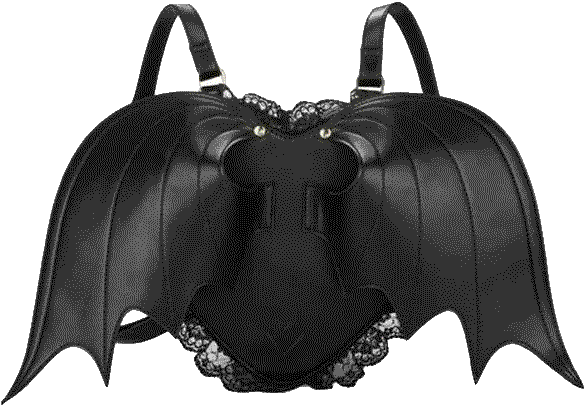
3
Bat Girl Backpack
2023
Kawaii Babe
Accessory
Gothic Lolita is subgroup of the Japanese Lolita fashion phenomenon which first arose in the 1990s around the Harajuku neighbourhood of Tokyo. Gothic Lolita draws on the romance of Victorian gothic for inspiration, with common motifs including bats, skulls, coffins, crosses, candelabra, deep red roses and castles. Gothic Lolita is seen as the dark counterpoint to classic Lolita fashion. Both share similar aesthetics, such as wide A-line skirts with petticoats, parasols, ribbons and lace, but Gothic Lolita is classic Lolita’s morbid cousin, presenting an uncanny doppelganger, two sides of the same mirror. The style was initially popularised by the singer Mana from the rock band Malice Mizer, a Japanese ‘visual kei’ rock band active from 1992 to 2001. The band was as famous for their music as they were for their live shows, featuring lavish historical costumes and stage sets. In 1999 Mana created the fashion label Moi-Même-Moitié (literally ‘Myself Half’, or as Mana has it, ’One’s alter ego as well as one’s self’) which specialised in Gothic Lolita clothing and accessories. Like members of other fashion subcultures, adherents of Gothic Lolita are skilled at reading the signifiers of their group which provide a sense of belonging and validation, allowing them to become part of a transnational community. Members of this community are at pains to distance themselves from the sexualising of the phenomenon, stating that by presenting themselves in such outlandish clothes, they are rejecting cultural constructions pertaining to the sexualised gaze. In addition, there are also men and non-binary people who adopt the style, suggesting a gender ambiguity and queering of the style.
words by Claire Catterall
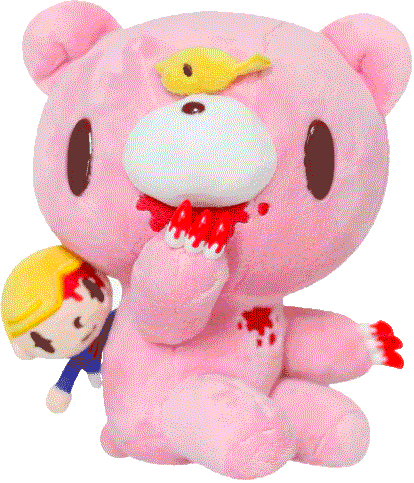
4
Gloomy Bear & Pity
2022
GE Entertainment
Plushie
Gloomy is the antithesis of the traditionally cute and friendly mascot. Despite appearing huggable with his pink, squishy exterior and recognisable teddy bear features, you do not want to get close to him. With massive claws, typically shown covered in blood, Gloomy represents a duality that blends the cuddly exterior of teddies with the actual nature of real bears. Gloomy’s owner, a little boy names Pitty, found him as a cub, and decided to adopt him thinking his seemingly innocent appearance was similar to a teddy bear’s. However, as Gloomy grew, he refused to be tamed and came to behave as he truly is – a wild animal. Created over two decades ago by Japanese graphic designer Mori Chack, Gloomy the Naughty Grizzly has become an iconic and unconventional character. Chack has also created other characters that retain a sense of the wild: Podolly, a sheep in a wolf skin, reversing the idea of a wolf in sheep’s clothing, and Kumakikai.
words by Ailinn Santos

5
‘Claire’ the Long Furby
2023
SoftPlush Studio
Plushie
Created by Tumblr user FurbyFuzz in 2018, the ‘long furby’ is an imaginary creature that builds on the 1999 Furby by Tiger Electronics. Elongated and insect-like, the long furby wriggles from dreams of fans of all things creepy-cute. Collectors document their escapades on forums and the Long Furby website, sharing ‘haunted photos from the dark recesses of the internet’. Long furby is part of a wider family of customisations of the 1990s toy; As a delightfully queer, non-binary icon, Furbys have populated online spaces in an array of vibrant furry forms including handbags, biblically accurate angels and mushroom spirits. Fans draw on Furby as a playfully cute toy that can be pushed to equally horrifying and surprising forms. Furby’s exaggerated puppetry and wild appearance lends itself to play; it’s rocking, cackling and vocalisations animate its animal hybridisation in a way that both suspends and confounds belief. Through this act of imaginative play, adults reach back to the playful horrors of their childhoods, combining their sense of dread with glee. As one of the first big virtual pets, Furby was thought to be a surveillance device and toy that might erode children’s capacity for care and emotion. Many millennials recall being convinced as children that their Furby was waiting for them in the dark, chuckling.
words by Dr Megan Catherine Rose
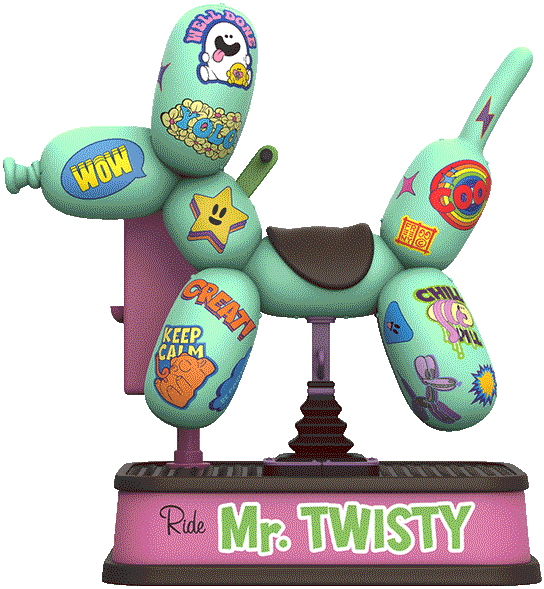
6
Mr Twisty (Vandalized Edition)
2023
Mighty Jaxx × Jason Freeny © Mighty Jaxx International
vinyl figure
Mr Twisty, a designer toy conceived by American artist Jason Freeny, draws inspiration from life-size kiddie rides commonly found in malls. However, Freeney replaces the conventional horse with a balloon dog, a playful yet precarious element that introduces an unexpected twist to the design in an echo of Jeff Koon’s famous sculpture, itself an homage to a children’s party favourite. This limited-edition ‘vandalized’ version is the second of Freeney’s Mr Twisty designs. Alongside the graphics, the toy is also covered in positive catchphrases such as ‘No Bad Vibes’. Strategically placed in a seemingly random manner, these phrases serve a purpose – they prompt a nostalgic journey back to childhood, encouraging viewers to perceive the world anew through innocent, colourful, and blissfully ignorant eyes.
words by Ailinn Santos

7
Freeny’s Hidden Dissectibles: My Little Pony
2022
Mighty Jaxx × Jason Freeny © Mighty Jaxx International
Vinyl figure
Released in 2022, Jason Freeny’s Hidden Dissectibles: My Little Pony series takes centre stage with its unnerving yet scientifically captivating exploration of the colourful ponies. The artist peels away their skin, offering a glimpse of what is beneath their typically adorable exteriors. Renowned for his anatomical art, Jason Freeny has gained worldwide recognition for his cutaway drawings and sculptures that reveal the inner workings of both inanimate objects and beloved pop cartoon characters. From gummy bears to SpongeBob and Care Bears, Freeny’s portfolio revolves around dissecting and exposing the inner mechanisms of pop culture icons, providing a thought-provoking perspective on the very essence that brings them to life – quite literally. Freeny’s meticulous dissections of well-known characters have garnered an international fanbase, causing these limited-edition toys, alongside other series inspired by Freeny’s work, to fly off the virtual shelves as soon as they hit online platforms. The allure of Hidden Dissectibles lies not only in Freeny’s dissection of the characters but also in his dissection of pop culture, sparking conversations about the layers of complexity that lie beneath the surface of our beloved childhood icons.
words by Ailinn Santos
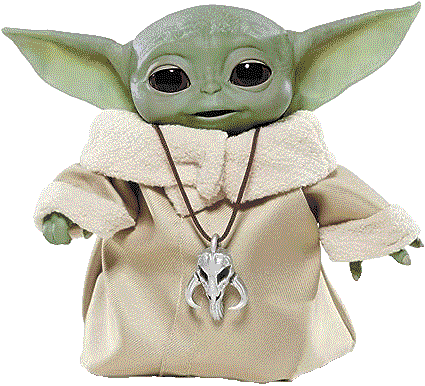
8
Star Wars the Child, Animatronic Edition
2020
Hasbro
Baby Yoda ‘s characteristics closely follow the Child Schema theory proposed by Austrian scientist Konrad Lorenz in the 1940s who described how a large head, big, wide-set eyes, short limbs, a rounded, soft body and wobbly movements are perceived as cute and trigger a caregiving response with the evolutionary function of enhancing offspring survival. Yet, Baby Yoda, as adorable as he may seem, is not so innocent and is capable of cruel and violent behaviour, demonstrating the ambivalent power of cuteness to be both childish and monstrous at once. His green wrinkled skin, oversized pointy ears and three-fingered mitts push his childishness into extraordinary dimensions. The cute monster is absolved from responsibility of operating within societal norms, instead offering a space outside of the normative to exist. Baby Yoda, real name Din Grogu, made his debut in the Star Wars TV series The Mandalorian in 2019. In the series, the protagonist known as ‘The Mandalorian’ is hired to track down and capture Grogu for a remnant of the fallen Galactic Empire, but instead, he becomes his adoptive father and protects him from the Imperials. Although referred to as ‘The Child’, Grogu is revealed to be 50 years old. He is a member of the same species as the Star Wars character Yoda.
words by Claire Catterall
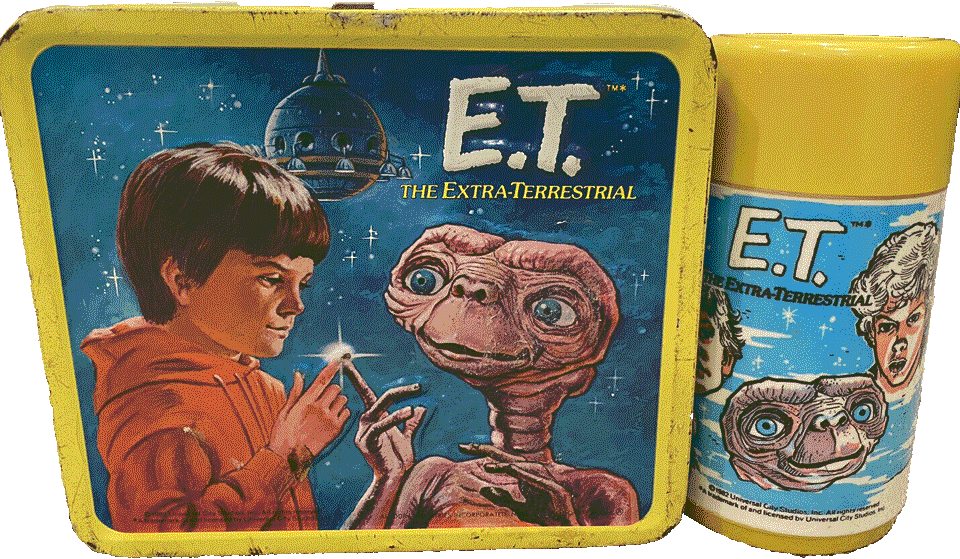
9
ET Lunchbox
1982
Aladdin Industries, Inc
Cuteness is intimately bound up with the history of the ‘freak’, as scholars such as Lori Merish have argued. She points out too the obvious parallels between the child and the freak: both liminal figures, residing on the boundaries that separate the ‘fully human’ from the ‘less-than-human’. Perhaps this is most evident in the figure of E.T., a cute monster (that only children can communicate with) in need of care and adoption. The grotesque monstrosity of the ‘alien’ E.T. does not diminish but rather intensifies his cuteness. Merish traces the history of the cute freak through the ancient times when dwarfs and midgets were kept as amusing accoutrements of court life. In the eighteenth century such figures were put on public display in taverns and carnivals, and by the 1840s, these exhibitions were consolidated in the commercialised spectacles known as ‘freak shows’. But, as Merish points out, ‘Haunted by its own freakishness, the cute ineluctably points to other possibilities of embodiment, other forms of subjectivity and desire.’ Cuteness moves mercurially between familiarity and unfamiliarity, childlike and monstrous, human and inhuman, offering myriad possibilities of becoming.
words by Claire Catterall

10
Pocket Neopets
2003
Hasbro
Game
Founded in 1999 by two university students, Neopets became a virtual sensation, allowing users to own and care for unique pets in the diverse online world of Neopia. From its humble origins aimed at entertaining university students, the site quickly grew, with interactivity soaring to 1 trillion page views by June 2011. Changes in ownership, including a stint with the Scientology Org Board, led to significant developments, such as the yearly Altador Cup gaming event as well as a failed attempt at Neopet NFTs. In terms of gameplay, Neopets offers players endless possibilities from customizing their cute, but monstrous pets with clothes, paints, and morphing brushes to battling against other Neopets. The game also features a unique economy and stock market called NEODAQ – a parody of the NASDAQ. In-game currency can be earned by purchasing and selling goods as well as engaging in immersive advertising, which is a controversial topic in the community due to concerns about marketing to minors. Neopets also delves into the real world with a range of merchandise, from clothing and jewellery to books, cereals, and portable games. The handheld version, Pocket Neopets, brings the online game on-the-go, where the mini screen becomes the main way to interact with your pet, while the figures and scenery add a touch of tactile fun.
words by Ailinn Santos
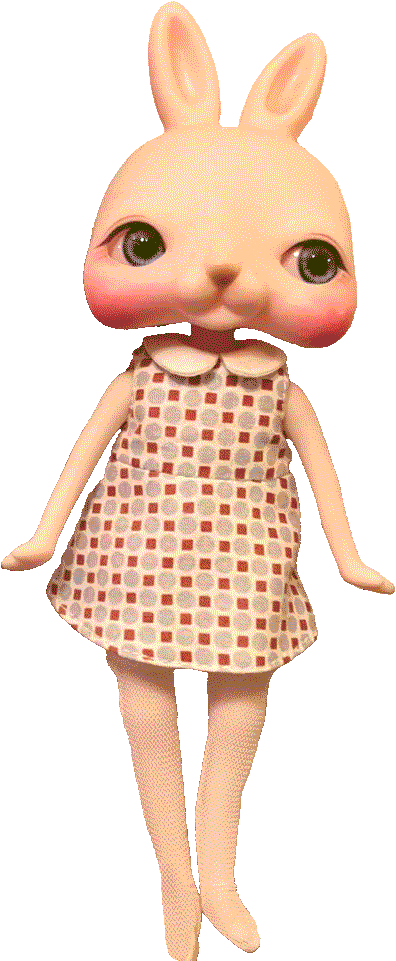
11
Mystery Rose II
2011
Tokissi, from The PolkAnok Collecton of Ania Goszczyńska and David Tibet
PVC doll
Mystery Rose II is a hand-made ball jointed doll by Korean doll artist Tokissi who, since launching her company in 2010, has garnered a devoted following. ‘Toki’ means bunny in Korean, while the suffix ‘ssi’ equates to ‘Mr.’ or ‘Miss’. Mystery Rose II was originally intended to be a ‘guardian angel’ figure – a small, ever-present protector, always by your side. Unlike most ball jointed dolls, which are made in human likeness, Tokissi is famous for her hybrid creations, fusing rabbit heads onto humanoid bodies. Ball jointed dolls, with articulated limbs, are hand-made in limited editions and are particularly popular in Japan, South Korea and China. They are made to be fully customisable, with hair, eyes, even heads, hands and feet able to be swapped. Often shortened to BJD, they are hyper realistic and have an unnerving lifelike quality. Intended for adult collectors, they can cost anything from $100 to $1000, with eyes costing from $30 to $100, and often with a couture wardrobe and accessories available to buy. BJDs are often named by their owners, treated like real people, and assigned personalities. Their uncanny appearance and the devotion they garner can seem strangely unsettling and they have, unsurprisingly, come to feature in many horror movies such as the Korean horror movie Doll Master 2004. Ball jointed dolls date back to articulated dolls made of wood and clay in Ancient Greece and Rome. Modern ball jointed dolls are inspired by the rich tradition of doll making in Japan and the influence of the German artist Hans Bellmer (1902-1975) who created dolls with articulated joints that he made into sculptures and surrealist photographic representations. The contemporary phenomenon of BJDs began in Japan in 1999 when the Japanese company Volks created the first Super Dollfie line of dolls. South Korean companies began producing dolls in 2002-3.
words by Claire Catterall

12
Duolingo Owl 10 Year Anniversary
2022
Duolingo
Plushie
Duolingo is a successful language-learning app at whose heart stands Duo, the app's official mascot. Launched in 2012 by co-founders Luis von Ahn and Severin Hacker, Duolingo boasts a staggering user base of over 300 million individuals and is the most popular language learning tool globally as of February 2023. Duolingo's success has given rise to a unique phenomenon—the ‘Evil Duolingo Owl’ meme. Fuelled by the app's reminder notifications encouraging users to practice, the original email featured a bawling Duo inspired memes depicting the owl hunting, stalking, or using humorous dark tactics to coerce users into completing their lessons. Embracing the playful spirit of these memes, the Duolingo team has incorporated them into their marketing strategy and social media presence on platforms like Instagram, Twitter, and TikTok. In doing so, Duolingo not only promotes language learning but also engages with its user community in an interactive and fun, yet sometimes terrifying, way.
words by Ailinn Santos
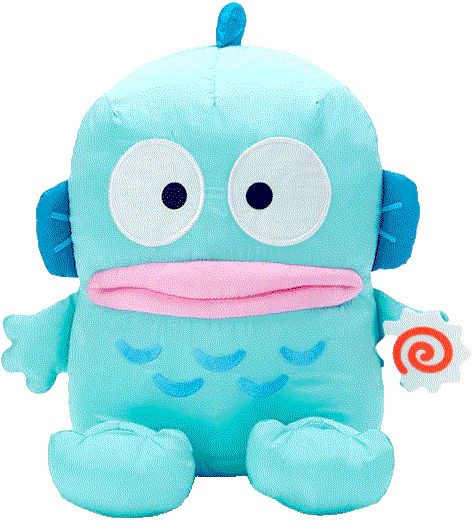
13
Hangyodon
2021
Sanrio
plushie
Debuting in 1985 as a member of Sanrio’s extensive collection of characters, Hangyodon, a male blue fish character envisioned by designer Hisato Inoue, bears a name that, when spelled out in Kanji, reads ‘half-fish man’, perfectly encapsulating his anthropomorphic nature. Inoue found inspiration in his own features to craft Hangyyodon’s unique appearance, characterized by distinctive round eyes and full lips. Despite sporting fins around his head and what appears to be scales on his body, a closer look at his limbs reveals a curious hybrid state – he is neither fully fish nor entirely human, but rather a peculiar fusion of the two. Although initially not met with overwhelming reception, Hangyodon has experience a remarkable shift in popularity, securing a top 8 spot in Sanrio’s Popularity Ranking in 2022. This surge is attributed to the affection of Gen Z individuals, who, according to Sanrio designer Harada Kaori, ‘have a soft spot for the character because of his peculiar fishy looks’. As a result, the character is now seen featured in anime movies and shows, taking on roles as a detective and spy.
words by Ailinn Santos
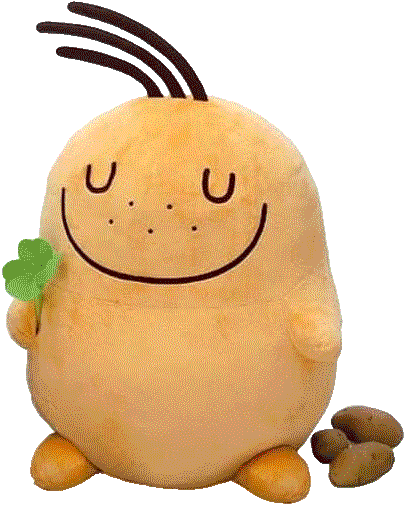
14
Jagabee
2013
Calbee
Plushie
The Japanese snack company Calbee is a veteran of using cute mascots for its products. On display is one of their more contemporary characters, Potta, a carefree potato fairy searching for the ‘Rainbow Potato’ that holds the special power of turning the world green. Born in 2006, Potta is attached to the fried potato sticks Jagabee, a wordplay combining the words ‘jaga’ from jagaimo (Japanese for potato) and ‘bee’ from the name Calbee. Originally introduced in 1975, Calbee’s first mascot, an anthropomorphic crisp character commonly called Potato Bouya (Potato Boy), was created a year later, in 1976. Potato Boya and Potta are now synonymous with potato crisps to anyone who grew up with Calbee’s snacks, showing how cuteness and food has enjoyed a long relationship, particularly in Asian countries where Calbee potato chips have a dominant market, but increasingly also in the West. Food mascots demonstrate how cuteness successfully plays on its desire to be consumed, in this case quite literally, enticing the customer to complete its destiny as a consumable product.
words by William Seung
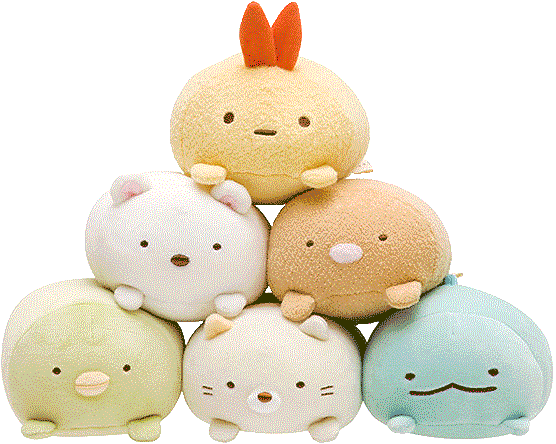
15
Sumikko Gurashi
2023
San-X, Courtesy ARTBOX, UK Kawaii Shop
plushie
Sumikko Gurashi is a franchise of the Japanese licencing product company San-X. Apart from a few exceptions, all characters are anthropomorphic beings that are either forgettable in daily life or possess flaws or insecurities. Among the characters on show are: - Shirokuma, a shy polar bear who migrated to avoid the cold - Penguin?, a green, self-doubting penguin-like creature - Tokatsu, a piece of pork cutlet leftover - Neko, a timid cat who has body image issue - Tokage, a lizard-pretending dinosaur fearful of getting caught - Tapioca, a cynical tapioca that was left in the cup as the bubble tea was drunk up - Suzume, a very common sparrow - Penguin (Real), a real cheerful penguin - Lizard (Real), a real carefree lizard As the franchise name literally translates to ‘life in the corner’, these characters find peace when staying together in the corner and always appear collectively. Yuri Yokomizo, the creator of this series, was inspired by a Japanese habit—a preference for the corner – and drew from her own predilection for corners, from the corner seat in a café to her doodles in the corner of her notebook. Cuteness often gives an abstract concept form while igniting resonance with us, heightening the appreciation of the small and seemingly insignificant things.
words by William Seung
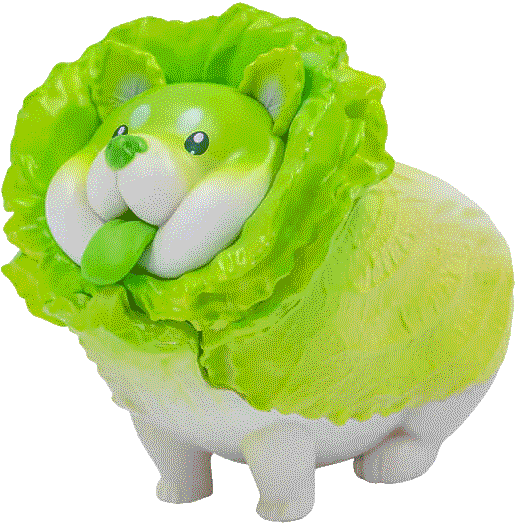
16
Vegetable Fairy series and Fruit Fairy series,
2020
Ponkichi, Courtesy dodowo and Hu Creates
Vinyl figures
Japanese illustrator and manga artist Ponkichi first created the Vegetable Fairy and Fruit Fairy series in 2020. These two franchises transform vegetables and fruits into adorable characters by blending them with animals, such as Chinese Cabbage Dog, Shitake Mushroom Weasel etc. The names of the fairies are often a wordplay such as Lychee-huahua (lychee and chihuahua), and each fairy has a short background story such as the Chinese Cabbage Dog who lives on a farm and loves getting his face smudged by his owner. Ponkichi’s motivation was to make vegetables and fruits appealing to children who are often very picky eaters, acutely demonstrating how cuteness transforms things that may appear bland and unpleasant, making them more relatable and attractive. But the cutification and anthropomorphising of food in Japanese culture has a long history, dating at least back to the Edo period (1603-1868), when food began to be seen as a source of pleasure rather than a rudimentary necessity. Perhaps the first visual representation of this was the artist Utagawa Kuniyoshi’s painting The Shakkyo Dance (1845) which depicts anthropomorphised cute edible vegetables in traditional dance costumes.
words by William Seung

17
Mang from BT21
2023
Line Friends Corporation, Courtesy ARTBOX, UK Kawaii Shop
Plushie
Created by BTS member J-Hope, MANG is a character sporting a unique light blue horse mask with a pink heart-shaped nose. Notably, MANG breaks traditional gender norms, identifying as non-binary or gender neutral. Introduced in 2017 as part of the BT21 universe, MANG is one of eight primary figures created through a collaboration between LINE Friends Corporations and the renowned K-Pop group BTS. Rather than creating avatars of the singers, BT21, the first project of LINE FRIENDS CREATORS, consists of charmingly cute characters imagined by each of the BTS members who oversaw the whole design process. MANG’s true appearance, a playful purple chipmunk-like character, is unveiled in one of LINE’s BT21 animated series titled ‘Inside MANG’ which explores the development of the character without their signature mask. This lively character has a passion for dancing, with CONN, a blue muscular horse, serving as their dance mentor and GWANG, a unicorn, as their jealous dance rival. MANG’s love for dance, coupled with their inclusive gender representation and cute appearance, has captivated fans worldwide and become a major branded character.
words by Ailinn Santos